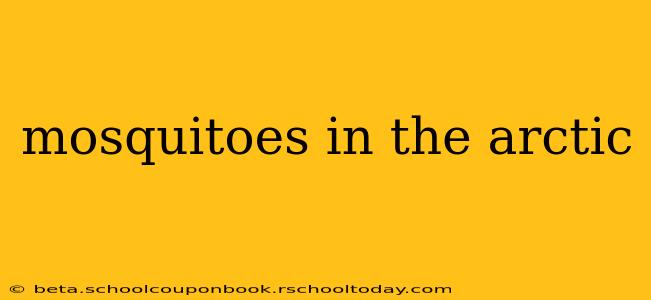The Arctic. A land of ice, snow, and… mosquitoes? While the image conjured might be one of stark, desolate beauty, the reality is far more… buzzing. Contrary to popular belief, mosquitoes are not absent from the Arctic regions. In fact, certain species thrive in the unique conditions, creating a surprisingly significant ecological impact and sometimes, a rather unpleasant experience for humans and animals alike. This article delves into the fascinating world of Arctic mosquitoes, exploring their survival strategies, ecological roles, and the challenges they pose.
The Species That Conquer the Cold: Arctic Mosquito Adaptations
Several mosquito species have adapted remarkably to survive the harsh Arctic environment. These aren't your average backyard pests. They've evolved specific traits to cope with freezing temperatures, short summers, and limited food sources. Key adaptations include:
- Diapause: Many Arctic mosquitoes spend a significant portion of their lives in a state of diapause, a form of suspended animation that allows them to survive the long, freezing winters. Eggs, larvae, and pupae can remain dormant for extended periods, waiting for the brief thaw of summer to resume their life cycle.
- Cold Tolerance: Arctic mosquitoes possess a remarkable tolerance for freezing temperatures. Their bodies produce cryoprotectants, specialized chemicals that prevent ice crystal formation within their cells, preventing damage and allowing them to survive sub-zero conditions.
- Rapid Development: The short Arctic summers demand a rapid life cycle. Arctic mosquito species have evolved to develop quickly, maximizing their reproductive potential within the limited window of warmth.
Ecological Roles: More Than Just a Nuisance
Despite their reputation as biting pests, Arctic mosquitoes play crucial roles within their ecosystems. They serve as a vital food source for various Arctic animals, including birds, fish, and even some mammals. Their larvae are also important components of the aquatic food web, providing sustenance for other invertebrates. The presence or absence of these insects can significantly impact the overall health and balance of the Arctic ecosystem.
The Impact of Climate Change: A Growing Concern
Climate change is significantly impacting Arctic ecosystems, and mosquitoes are no exception. Warmer temperatures and longer summers are leading to increased mosquito populations and expanded ranges. This can have several consequences:
- Increased Biting and Disease Transmission: Larger mosquito populations mean more bites, potentially increasing the risk of disease transmission to humans and animals. While diseases transmitted by Arctic mosquitoes are currently considered low risk, this could change with increased populations and range expansion.
- Altered Ecosystem Dynamics: Changes in mosquito populations can disrupt the delicate balance of the Arctic food web, affecting the populations of predator species that rely on them as a food source.
- Impact on Human Activities: The increased presence of mosquitoes can hinder human activities in the Arctic, affecting tourism, research, and other endeavors.
Human Interaction and Management Strategies
Dealing with Arctic mosquitoes requires a multi-pronged approach, considering both the ecological role of these insects and their impact on human activities. Strategies may include:
- Repellents: Using effective insect repellents is crucial for protecting oneself from bites.
- Protective Clothing: Wearing long sleeves and pants can significantly reduce exposure to mosquito bites.
- Habitat Modification: While large-scale habitat modification is generally not feasible or advisable in the delicate Arctic ecosystem, targeted efforts to manage mosquito breeding grounds could be considered in specific areas.
- Research and Monitoring: Ongoing research is essential to understand the impact of climate change on Arctic mosquito populations and to develop effective management strategies.
Conclusion: A Tiny Insect, A Big Impact
The humble Arctic mosquito, despite its diminutive size, plays a surprisingly significant role in the Arctic ecosystem. Its adaptations to the harsh environment are remarkable, and its response to climate change highlights the broader consequences of global warming. Understanding these insects and their interactions within the Arctic environment is crucial for managing the ecological impacts of climate change and for ensuring the well-being of both the Arctic ecosystem and the people who live and work in these remote regions.
